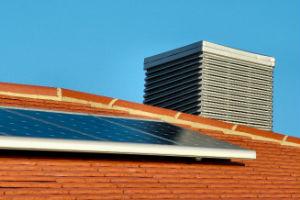 It is worth assuming the additional cost involved in acquiring a series of small resources and components, because in the short term the investment is recovered and allows us to achieve staggered savings.
It is worth assuming the additional cost involved in acquiring a series of small resources and components, because in the short term the investment is recovered and allows us to achieve staggered savings.by: Alfredo Sotolongo
As I have always told you, energy savings are achieved not only with the larger equipment that makes up the air conditioning system, but also with the sum of many small components.
On several occasions we have realized that the additional cost in the small components, reflects savings in consumption that allow to recover the same in a very short time.In the constant search for those small components I have confirmed that the application of the partial diversion of the return air, so that it does not pass through the cooling coil, helps to reduce humidity without the need for additional energy consumption, minimizing the initial cost of the air conditioning unit. Of course, like everything, this has certain limitations.
The three main conditions for the partial diversion of the return air to be applied correctly are:
1.That the unit is of constant volume.
2.That the thermal load of the conditioned area has a sensitive heat ratio (SHR) of at least 0.7, that is, little latent heat.
3.That the humidity of the mixture of the outside air and the return air is greater than that of the return air.
But when the sensible heat ratio is less than 0.7, reheating by heat is usually required, preferably modulating hot gas.
The purpose is for the mixture of the ventilation outside air along with some of the return air to pass through the cooling coil to cool them and remove moisture. The mixture comes out of the cooled cooling coil and to reheat it, instead of using additional energy, it simply overheats by mixing with the return air that had been partially diverted from the cooling coil.
This is achieved by gates positioned by modulating operators that respond to the temperature and humidity control system that is an integral part of the unit and key to achieving this concept. The return air that partially deviates from the cooling coil and then mixes with the air that comes out of the coil has already returned to the unit with the necessary conditions to achieve the necessary overheating. The return air has already been processed by the air conditioning unit and also returns warmer by removing the thermal load from the conditioned area.
It is important to note that when using the partial return air diversion system to reheat the supply air, even if the above conditions are met most of the time, sometimes conditions may occur that do not meet. In many of those cases it is possible that by adjusting the relative humidity checkpoint, the temperature of the conditioned area can be increased without sacrificing occupant comfort and maintaining energy savings. According to the ASHRAE 55 standard, which refers to the design conditions to satisfy the comfort of humans present in the conditioned area, if the humidity is reduced and kept under control, the temperature can be increased without affecting the thermal comfort of the occupants.
The company AAON, which has invested considerable resources in research and development of multiple energy conservation systems, offers units with partial diversion of the return air with their corresponding controls integrated to these units in capacities from 6 to 230 tons of refrigeration. The units with these components have obtained excellent results in applications such as supermarkets, schools, printing presses, computer centers, LEED buildings and industries among others.
I can tell you, without fear of being mistaken, that in any application with a relatively low latent heat the partial diversion system of the return air can be applied as long as the unit has integrated the controls to achieve it. These small components meet both ventilation and energy consumption standards with minimal investment.
If you wish to contact me for any questions regarding this or any other of my Opinion Articles, you can do so at my email: [email protected]













